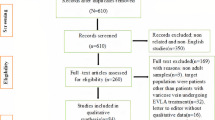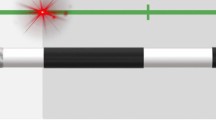Abstract
Endovenous laser therapy (EVLT) or endovenous laser ablation (EVLA) was introduced as a minimally invasive treatment for varicose veins. Lasers work by producing endovenous thermal damage and hence obliteration of the diseased vein. The short- and long-term efficacy and extent of ablative damage and also the complications of pain, phlebitis, etc. are dependent to some extent on the wavelength of the laser. There are continuous modifications in the wavelength used with the aim of minimizing side effects and improving efficiency. Different laser systems as well as varying application strategies are under study. Investigational research and close analysis have helped in a better understanding of the relationship between the clinical efficacy and the physical aspects of the laser with a continuous refinement of treatment.
Access this chapter
Tax calculation will be finalised at checkout
Purchases are for personal use only
Similar content being viewed by others
References
Navarro L, Min RJ, Bone C. Endovenous laser: a new minimally invasive method of treatment for varicose veins--preliminary observations using an 810 nm diode laser. Dermatol Surg. 2001;27(2):117–22.
De Felice E. Shedding light: laser physics and mechanism of action. Phlebology. 2010;25:11–28.
Sroka R, Weick K, Sadeghi-Azandaryani M, Steckmeier B, Schmedt CG. Endovenous laser therapy – application studies and latest investigations. J Biophotonics. 2010;3:269–76.
Neimz MH. Laser tissue interactions. Fundamentals and applications. 3rd ed. Berlin: Springer; 2003.
Welch AJ, Torres JH, Cheong W-F. Laser physics and laser tissue interaction. Tex Heart Inst J. 1989;16:141–9.
Carruth JAS, McKenzie AL. Medical lasers. Science and clinical practice. Bristol: Adam Hilger; 1986.
Proebstle TM, Moehler T, Gül D, Herdemann S. Endovenous treatment of the great saphenous vein using a 1,320 nm nd: Yag laser causes fewer side effects than using a 940 nm d: Yag laser causes fewer side effects than using a 940 nm diode laser. Dermatol Surg. 2005;31:1678–84.
Proebstle TM, Krummenauer F, Gu¨l D, Knop J. Nonocclusion and early reopening of the great saphenous vein after endovenous laser treatment is fluence dependent. Dermatol Surg. 2004;30:174–8.
Timperman TE, Sichlau M, Ryu RK. Greater energy delivery improves treatment success of endovenous laser treatment of incompetent saphenous veins. J Vasc Interv Radiol. 2004;15(10):1061–3.
Proebstle TM, Moehler T, Herdemann SJ. Reduced recanalization rates of the great saphenous vein after endovenous laser treatment with increased energy dosing: definition of a threshold for the endovenous fluence equivalent. J Vasc Surg. 2006;44(4):834–9.
Kim HS, Nwankwo IJ, Hong K, McElgunn PS. Lower energy endovenous laser ablation of the great saphenous vein with 980 nm diode laser in continuous mode. Cardiovasc Intervent Radiol. 2006;29(1):64–9.
Desmyttère J, Grard C, Wassmer B, Mordon S. Endovenous 980-nm laser treatment of saphenous veins in a series of 500 patients. J Vasc Surg. 2007;46(6):1242–7.
Kontothanassis D, Di Mitri R, Ruffino SF, Ugliola M, Labropoulos N. Endovenous thermal ablation. Standardization of laser energy: literature review and personal experience. Int Angiol. 2007;26(2):183–8.
Vuylsteke M, Liekens K, Moons P, Mordon S. Endovenous laser treatment of saphenous vein reflux: how much energy do we need to prevent recanalizations? Vasc Endovasc Surg. 2008;42:141–9.
Elmore FA, Lackey D. Effectiveness of endovenous laser treatment in eliminating superficial venous reflux. Phlebology. 2008;23:21–31.
Chang CJ, Chua JJ. Endovenous laser photocoagulation (EVLP) for varicose veins. Lasers Surg Med. 2002;31(4):257–62.
Schmedt CG, Sroka R, Steckmeier S, Meissner OA, Babaryka G, Hunger K, Ruppert V, Sadeghi-Azandaryani M, Steckmeier BM. Investigation on radiofrequency and laser (980 nm) effects after endoluminal treatment of saphenous vein insufficiency in an ex-vivo model. Eur J VascEndovasc Surg. 2006;32(3):318–25.
Anderson RR, Parrish JA. Selective photothermolysis: precise microsurgery by selective absorption of pulsed radiation science. Science. 1983;220:524–7.
Proebstle TM, Sandhofer M, Kargl A, et al. Thermal damage of the inner vein wall during endovenous laser treatment: key role of energy absorption by intravascular blood. Dermatol Surg. 2002;28:596–600.
Proebstle TM, Lehr HA, Kargl A, Espinola-Klein C, Rother W, Bethge S, Knop J. Endovenous treatment of the greater saphenous vein with a 940-nm diode laser: thrombotic occlusion after endoluminal thermal damage by laser-generated steam bubbles. J Vasc Surg. 2002;35:729–36.
Fan C-M, Rox-Anderson R. Endovenous laser ablation: mechanism of action. Phlebology. 2008;23:206–13.
Corcos L, Dini S, De A, et al. The immediate effects of endovenous diode 808-nm laser in the greater saphenous vein: morphologic study and clinical implications. J Vasc Surg. 2005;41:1018–24.
Min RJ, Khilnani NM. Endovenous laser ablation of varicose veins. J Cardiovasc Surg. 2005;46(4):395–405.
Manfrini S, Gasbarro V, Danielsson G, Norgren L, Chandler JG, Lennox AF, et al. Endovenous management of saphenous vein reflux. Endovenous Reflux Management Study Group. J Vasc Surg. 2000;32:330–42.
Diessehf BC, Rem AI, Verdaasdonk RM, Kinderen DJ, Moll FL. Endovenous laser ablation: an experimental study on the mechanism of action. Phlebology. 2008;23:69–76.
Pannier F, Rabe E, Maurins U. First results with a new 1470-nm diode laser for endovenous ablation of incompetent saphenous veins. Phlebology. 2009;24:26–30.
Goldman MP, Mauricio M, Rao J. Intravascular 1320-nm laser closure of the great saphenous vein: a six to 12-month follow-up study. Dermatol Surg. 2004;30:1380–5.
Theivacumar N, Beale R, Mavor A, Gough M. Factors influencing the effectiveness of endovenous laser treatment (EVLT) for varicose veins due to sapheno-femoral (SF) and long saphenous (LSV) reflux. Eur J Vasc Endovasc Surg. 2008;35:119–23.
Bedi HS, Calton N, Kwatra KS, Tewarson V. Histopathological findings of the human great saphenous vein treated with endoluminal radio frequency ablation. Int Surg J. 2014;1(1):3–5.
Proebstle T, Moehler T, Gul D, et al. Endovenous treatment of the great saphenous vein using a 1,320 nm Nd:YAG laser causes fewer side effects than using a 940 nm diode laser. Dermatol Surg. 2005;31:1678–83.
Kuenstner JT, Norris KH. Spectrophotometry of human hemoglobin in the near infrared region from 1000 to 2500 nm. J Near Infrared Spectrosc. 1994;2:59–65.
Vuylsteke ME, Vandekerckhove PJ, De Bo T. Use of a new endovenous laser device: results of the 1,500 nm laser. Ann Vasc Surg. 2010;24:205–11.
Vuylsteke ME, Mordon SR. Endovenous laser ablation: a review of mechanism of action. Ann Vasc Surg. 2012;26(3):424–33.
Vuylsteke ME, Martinelli TH, VanDorpe J, et al. Endovenous laser ablation: the role of the intraluminal blood. Eur J Vasc Endovasc Surg. 2011;42:120–6.
Pannier F, Rabe E, Rits J, Kadiss A, Maurins U. Endovenous laser ablation of great saphenous veins using a 1470 nm diode laser and the radial fibre-follow-up after 6 months. Phlebology. 2011;26:35–9.
Schwartz T, von Hodenberg E, Furtwangler C, Rastan A, Zeller T, Neumann FJ. Endovenous laser ablation of varicose veins with the 1470 nm diode laser. J Vasc Surg. 2010;51:1474–8.
Doganci S, Demirkilic U. Comparison 0f 980 nm laser and bare tip fibre with 1470 nm laser and radial fibre in the treatment of great saphenous vein varicosities: a prospective randomized clinical trial. Eur J Vasc Endovasc Surg. 2010;40:254–9.
Kabnick L. Outcome of different endovenous laser wavelengths for great saphenous vein ablation. J Vasc Surg. 2006;43:88–93.
Author information
Authors and Affiliations
Editor information
Editors and Affiliations
Rights and permissions
Copyright information
© 2018 Springer Nature Singapore Pte Ltd.
About this chapter
Cite this chapter
Bedi, H.S., Bedi, Y.S. (2018). Relevance of Wavelength in Laser Treatment of Varicose Veins. In: Khanna, A., **dal, R. (eds) Venous Disorders. Springer, Singapore. https://doi.org/10.1007/978-981-13-1108-6_5
Download citation
DOI: https://doi.org/10.1007/978-981-13-1108-6_5
Published:
Publisher Name: Springer, Singapore
Print ISBN: 978-981-13-1107-9
Online ISBN: 978-981-13-1108-6
eBook Packages: MedicineMedicine (R0)




